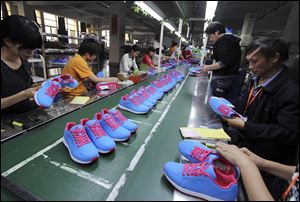
Survey shows more Chinese want U.S. label
Researcher cites perception of quality, strength of brands
11/28/2012
Chinese-made goods such as these shoes would be less desirable than U.S.-made counterparts to China’s prospering middle and upper classes, said Paul Zito of the Regional Growth Partnership.
Within reach of your desk or most comfortable armchair you can probably find something that was made in China. Wish more of your goods were instead stamped “Made in the USA”?
Apparently, so do many Chinese.
New research from the Boston Consulting Group found more than 60 percent of Chinese consumers are willing to pay more for goods made in the United States, and almost half would prefer a U.S.-made product over a Chinese-made one of similar quality and price.
Considering the amount of made-in China goods sold in the United States, the findings seem a bit odd. However, there’s solid logic behind the results.
“We were also struck that so many Chinese consumers were interested in [U.S.-made goods], but it makes sense given the quality perception and the brand strength of many of the U.S. manufacturing companies,” said Kate Manfred, leader of Boston Consulting Group’s Center for Consumer and Customer Insight in the Americas and a survey co-author.
The survey found Chinese consumers felt U.S.-made goods were of a better quality, more durable, and more environmentally friendly than their Chinese counterparts.
The way the study was conducted — showing different groups photos of the same items marked either “Made in China” or “Made in the United States” and asking them what price they would be willing to pay — didn’t rely on brand recognition.
Ms. Manfred said items from well-known Western brands that are made in the United States probably would command even higher premiums, but being made in the United States alone is enough to boost prices 10 top 60 percent, depending on the item.
The findings weren’t a big surprise to the Regional Growth Partnership’s Paul Zito, who recently returned from a nine-day trade trip to China.
“I think the quality of U.S. goods is known around the world,” Mr. Zito said. “The Chinese middle class and upper class are in a position where they are able to afford imported goods on a consumer level, and they’d like to go with the best.”
Boston Consulting Group said the findings suggest significant opportunities for U.S. companies to export products and bring manufacturing operations back from overseas.
Rising wages in countries such as China give companies even less incentive to manufacture products there.
“From a cost perspective, we believe many industries are going to hit the tipping point. You add the marketing and consumer perspective, there’s ... a real demand for consumers for U.S.-made goods. It may just accelerate this reshoring phenomenon,” Ms. Manfred said.
Stan Westjohn, an assistant professor of international marketing at the University of Toledo, said consumers in emerging economies are often drawn to goods made in more modern locales.
“It’s not surprising that’s a finding of theirs, and I think it stems from a lack of confidence in the companies based inside emerging markets,” he said.
The survey also found two-thirds of U.S. consumers are willing to pay a premium for U.S.-made goods. How large a premium varies by the item and between the countries.
For example, Chinese consumers said they'd pay on average 8 percent more for a toy made in the United States, but American consumers reported they’d pay 66 percent more to have an American-made toy.
How well consumers execute that desire is debatable, however. Mr. Westjohn’s research has found consumer knowledge of where things are made — and even where brands are headquartered — is often lacking.
“There’s really poor calibration of their knowledge of where brands are headquartered,” he said. “That said, where they perceive a brand to be associated can influence their feelings toward those brands.”
As an example, Mr. Westjohn said many consumers think Samsung is a Japanese brand. It’s actually Korean. In that case, the misconception may help Samsung. Consumers often associate high-end, high-quality electronic goods with Japan, but Korean goods may not have the same kind of luster.
To the broader point of whether manufacturing can regain some footing in the United States, Mr. Westjohn said there are many trends that seem to indicate it will.
“A potential real big boon for us manufacturing is the cost of energy,” he said. “Provided the government allows companies to extract this liquefied natural gas out of the ground, it could make U.S. industry super competitive in terms of cost of energy.”
The group’s survey also looked at consumers in Germany and France. A majority of participants in both of those countries prefer and are willing to pay more for items made within their own borders.
Contact Tyrel Linkhorn at: tlinkhorn@theblade.com or 419-724-6134.